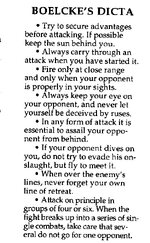FLYBOYJ
"THE GREAT GAZOO"
I'm no pilot, but I reckon turning into the attack makes target acquisition harder and shortens firing time for the attacker as well. Both are good things when you're being bounced, I bet.
1. Always try to secure an advantageous position before attacking. Climb before and during the approach in order to surprise the enemy from above, and dive on him swiftly from the rear when the moment to attack is at hand.
2. Try to place yourself between the sun and the enemy. This puts the glare of the sun in the enemy's eyes and makes it difficult to see you and impossible for him to shoot with any accuracy.
3. Do not fire the machine guns until the enemy is within range and you have him squarely within your sights.
4. Attack when the enemy least expects it or when he is preoccupied with other duties such as observation, photography, or bombing.
5. Never turn your back and try to run away from an enemy fighter. If you are surprised by an attack on your tail, turn and face the enemy with your guns.
6. Keep your eye on the enemy and do not allow him to deceive you with tricks. If your opponent seems damaged, follow him down until he crashes to be sure he is not faking.
7. Foolish acts of bravery only bring death. The Jasta (squadron) must fight as a unit with close teamwork between all pilots. The signals of its leaders must be obeyed.
8. For the Staffel (squadron): Attack in principle in groups of four or six. When the fight breaks up into a series of single combats, take care that several do not go for one opponent
Dicta Boelcke

